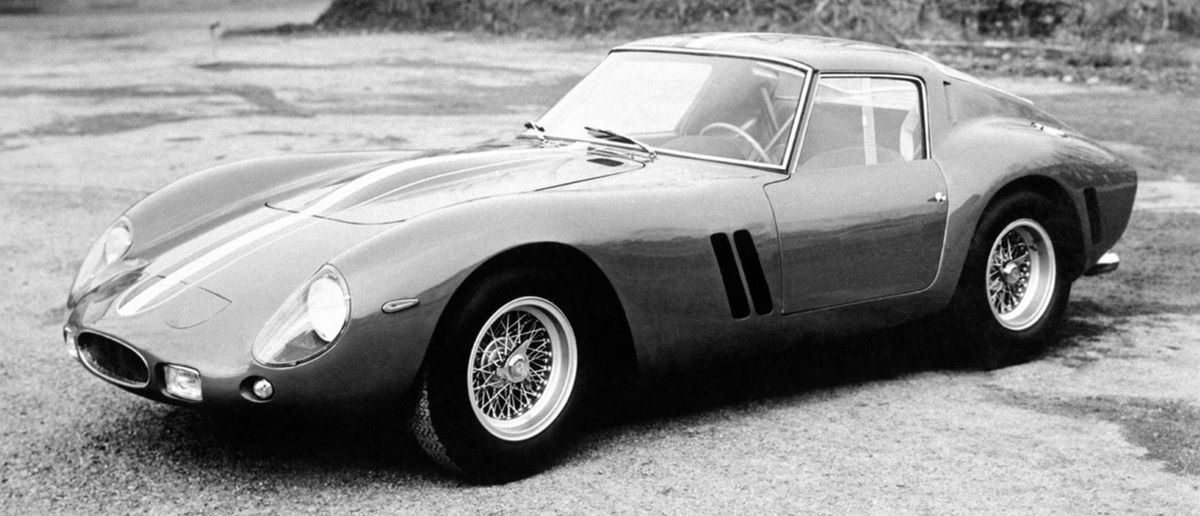
The 250 GTO model was the pinnacle of development of the 250 GT series in competition form, whilst still remaining a road car. It made its public debut at the annual pre-season Ferrari press conference in January 1962, and was the only front engine model on display, with its monoposto and sports racing counterparts all having a mid-engine configuration.
This model had no tail spoiler, but one was added before its competition debut at the Sebring circuit in America in March 1962. On its maiden outing in the 12 Hour Race, driven by Phil Hill and Olivier Gendebien, the 250 GTO finished second overall to a Ferrari 250 Testa Rossa sports racing car. It also won the GT category comfortably, an impressive debut performance upon which it would build during the next three years.
The model was built on a 2400 mm wheel base, as had been the 250 GT ‘SWB’ from which it was derived. Although the chassis was built along the same lines, it used smaller section tubing, with additional bracing for increased torsional rigidity, and was given factory type reference 539/62 Comp., and then 539/64 Comp. Like the earlier 250 GT ‘SWB’ Berlinettas, four wheel disc brakes were fitted, with a cable-operated handbrake to the rear wheels, and it was also available as both a left- and right-hand drive.
Early development of the new model was shrouded in secrecy, with Giotto Bizzarrini charged with developing a car to take on and beat the Jaguar E Type. In various interviews over the years he has said he was given an old 250 GT Boano chassis as a basis for the project. However, internal factory records show that he was provided with a 250 GT ‘passo corto’ (chassis 1791GT) on which to base the new car. On its first outing at Monza in September 1961, prior to the Italian Grand Prix, the 250 GTO earned the nickname ‘Il Mostro’ (The Monster), due to its rough-hewn and ill fitting prototype body. During test sessions, Stirling Moss drove the car to record times far better than those ever achieved by a 250 GT ‘passo corto’. A ‘palace revolution’ followed later in the year, and Bizzarrini found himself on the outside, with refinement of the GTO body entrusted to Sergio Scaglietti, who created its definitive shape.
The power unit was essentially a 250 Testa Rossa specification version of the Colombo single overhead camshaft per bank 3-litre V12 engine, with bore and stroke of 73 x 58.8 mm, but using dry sump lubrication, with factory type reference 168 Comp/62. The spark plugs were outside the vee of the block, and there was a bank of six twin choke Weber 38 DCN carburettors, with a twin coil and rear of engine mounted distributor ignition system, to produce a claimed 300 bhp. The engine was coupled to a new 5-speed, all synchromesh gearbox, with an open gate gear-change tower in the cockpit, similar to that used on the sports racing models since the mid-fifties, driving through a propeller shaft to the rigid rear axle, fitted with a Watts linkage. As befitted its intended competition use, a wide range of rear axle ratios was available.
The overall shape of the aluminium bodies designed and built by Scaglietti changed very little during the production period from 1962 to 1964, apart from a one-off example bodied in the style of the 330 LM Berlinetta. The last three cars in the series received Pininfarina-designed and Scaglietti-built bodies of a style very similar to that used on the mid-engine 250 LM sports racing car. Four earlier cars were also re-bodied in the later style during 1964. Although the overall body shape didn’t alter to any great degree, the detail differences during the production run certainly did. The early cars in the series had a small elliptical radiator opening, bounded by rectangular driving lights, initially with brake cooling ducts under the nose, which then changed to vertical brake cooling slots in the nose alongside the driving lights, with the sidelights mounted below the Plexiglass shrouded headlights. The rear spoiler was bolted to the tail panel, and there were cabin exhaust air slots in the sail panels. The brake cooling ducts soon became circular, and the side lights moved to a semi-recessed location in the wing sides; a little while after these modifications the tail spoiler, still of the same profile, became an integral, riveted part of the body construction.
All of the examples produced, apart from the ’64-bodied cars, had three removable ‘D’-shaped panels, retained by quarter turn fasteners, on the upper face of the nose, for increased radiator air throughput, the pattern being repeated with three similar uncovered openings in the underside of the nose panel. The ’64-bodied cars and re-bodies again have detail differences between individual cars, but these relate more to the roof shape, which was either long, short with integral spoiler, or short without spoiler and the bonnet, which either had a long slim bulge tapering into the nose panel or a cold air intake. A number of cars were modified during their competition careers, notably with the addition of a third front wing exhaust air slot, and occasionally louvres were added to the bonnet to aid heat dissipation. Apart from these main points, there were numerous individual differences between the various cars, i.e. some had the rear lights mounted on raised ‘bridges’, while others had them fixed directly to the tail panel.
The 250 GTO Berlinettas continued the run of successes of the preceding ‘passo lungo’ and ‘passo corto’ models, and with the manufacturers’ championship being transferred to the GT category from 1962, gave Ferrari a hat trick of victories between 1962 and 1964. They were virtually dominant in their class, and were only being caught by the AC Cobras (with much larger capacity V8 engines) during their last competitive year. Amongst the numerous international successes of the 250 GTO were wins in the Tour de France in 1963 and 1964; GT class wins in the Targa Florio in 1962, 1963 and 1964; victories in the Tourist Trophy at Goodwood in 1962 and 1963; with GT category wins at Le Mans in 1962 and 1963, and in the Nurburgring 1000 km in 1963 and 1964.
The 250 GTO was the ultimate expression of the Ferrari 250 GT car. It was equally at home on the road or track – perhaps the last dual purpose road/race car produced – and has achieved legendary status amongst aficionados of the marque. With only a relatively small production run of thirty-six cars, and with many of the examples produced having a great race pedigree, it has become one of the icons of Ferrari production history, with a revered position in collector’s circles.
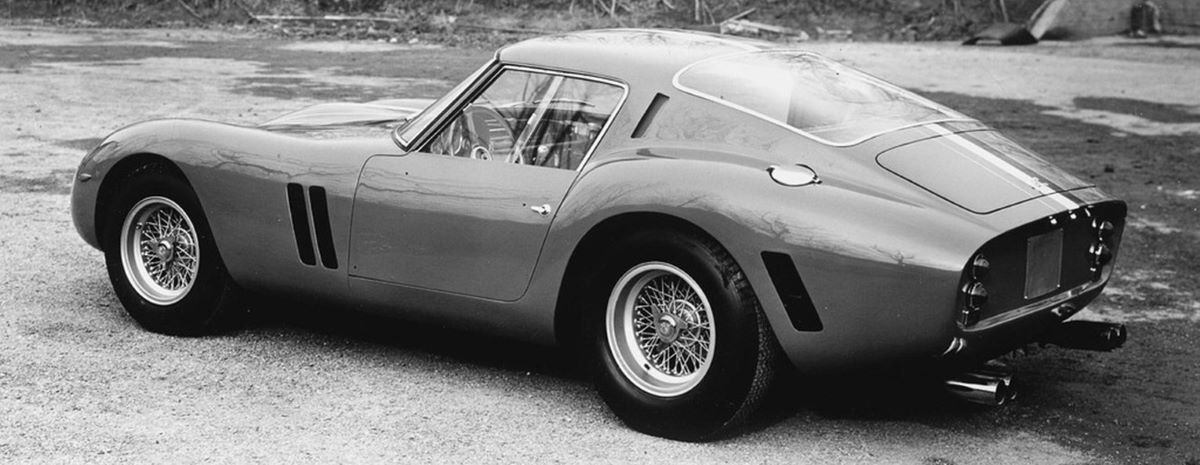
Engine
- Type front, longitudinal 60° V12
- Bore/stroke 73 x 58.8 mm
- Unitary displacement 246.10 cc
- Total displacement 2953.21 cc
- Compression ratio 9.8 : 1
- Maximum power 221 kW (300 hp) at 7400 rpm
- Power per litre 102 hp/l
 Valve actuation single overhead camshafts per bank, two valves per cylinder
Valve actuation single overhead camshafts per bank, two valves per cylinder- Fuel feed six Weber 38 DCN carburettors
- Ignition single spark plug per cylinder, two coils
- Lubrication dry sump
- Clutch single-plate
Performance
- Top speed 280 km/h

Chassis
- Frame tubular steel
- Front suspension independent, unequal-length wishbones, co-axial coils and telescopic shock absorbers, anti-roll bar
- Rear suspension live axle, twin radius arms, semi-elliptic springs, co-axial coil springs and telescopic shock absorbers
- Brakes discs
- Transmission 5-speed + reverse
- Steering worm and roller
- Fuel tank capacity 130 litres
- Front tyres 6.00 x 15
- Rear tyres 7.00 x 15
Bodywork
- Type two-seater berlinetta
- Length 4325 mm
- Width 1600 mm
- Height 1210 mm
- Wheelbase 2400 mm
- Front track 1354 mm
- Rear track 1350 mm
- Weight 880 kg (dry)
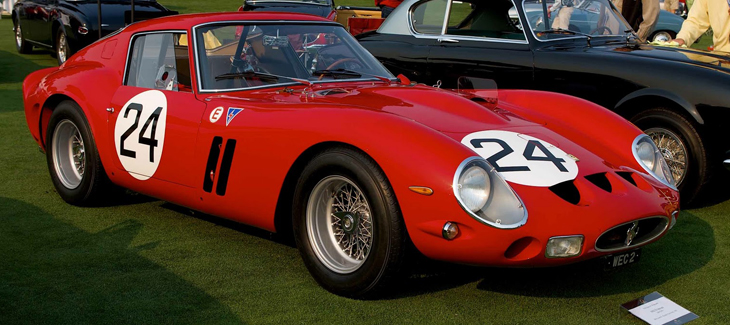

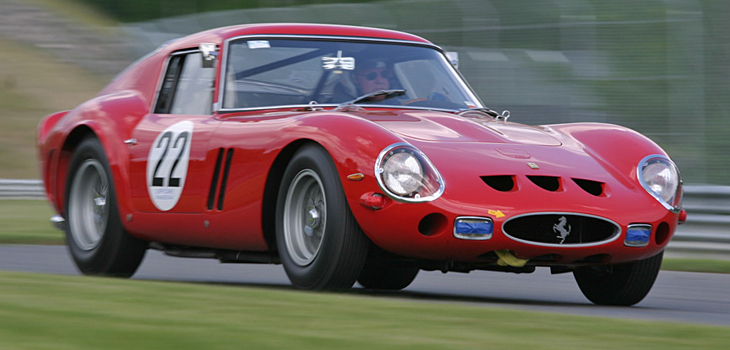

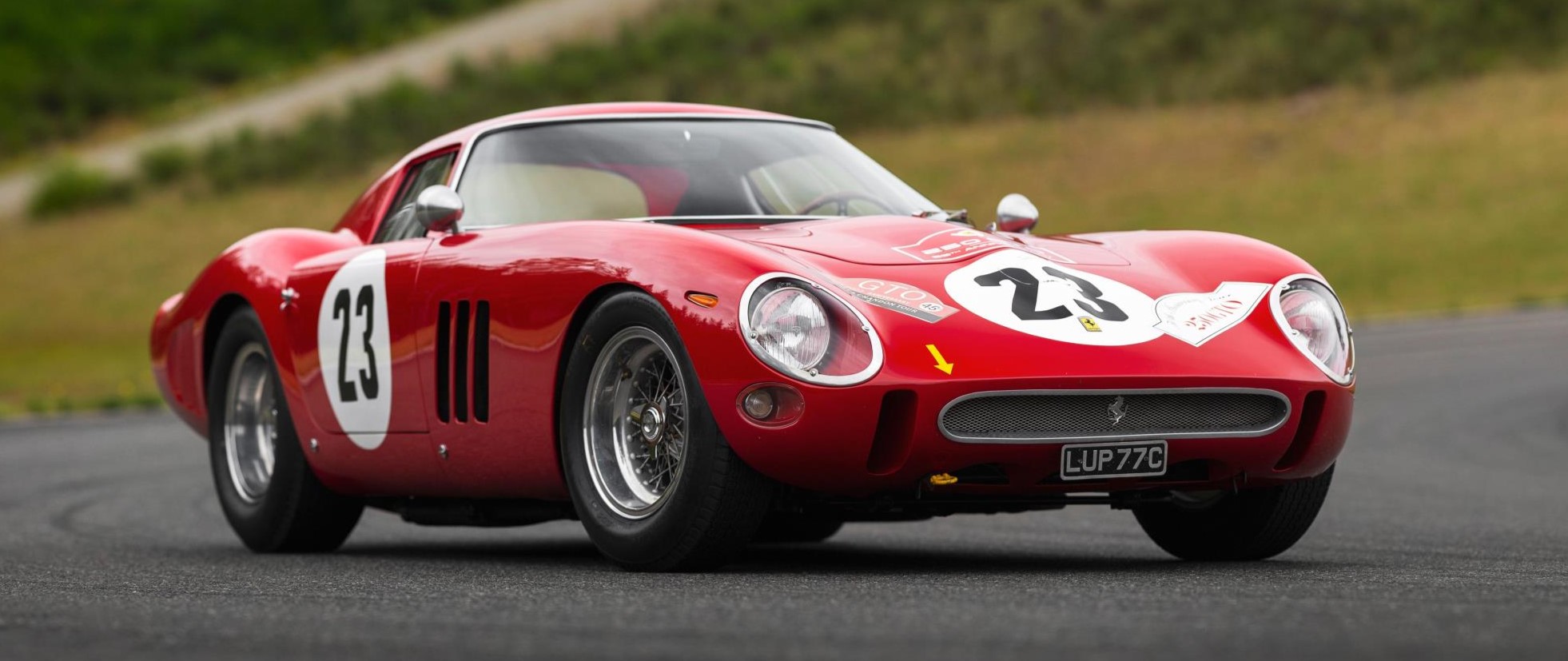
1962 Ferrari 250 GTO by Scaglietti
- Sold For $48,405,000RM | Sotheby’s – MONTEREY 2018
- Chassis No.3413 – Engine No.3413 – Gearbox No.5
- The world’s most important, desirable, and legendary motor car
- The third of only 36 GTOs built; considered by marque experts to be one of the most authentic and original of all GTO examples
- One of four upgraded in period by Scaglietti with Series II GTO/64; one of seven to ever receive this more aggressive and successful coachwork
- Driven by Edoardo Lualdi-Gabardi to victory in the 1962 Italian GT Championship
- Key contributor to Ferrari’s victory in the 1964 International Championship for GT Manufacturers with its class win in the 1964 Targa Florio
- Over 15 class and overall wins during the 1962–1965 seasons
- 1st in class at the 1963 Targa Florio, driven by Gianni Bulgari and Maurizio Grana
- 1st in class at the 1964 Targo Florio, driven by Corrado Ferlaino and Luigi Taramazzo
- Inspected by both marque specialist Marcel Massini and Ferrari Classiche representatives
- Exclusive access to some of the world’s most prestigious events and rallies, including to the famed GTO club and tours

TARGA FLORIO, PALERMO, SICILY, 26 APRIL 1964
The weather is warm and dry on this spring morning in Sicily and fans begin lining the public roads of the towns and winding mountainous stretches surrounding the city of Palermo. The 48th running of the legendary Targa Florio is only minutes away, and it is proving to be yet another glorious battle of man and machine against the clock and the elements of surprise that make motor racing purely a sport for the most daring gentlemen drivers in the world. This is, after all, the oldest sports car race in the world, and victory here is more than a fleeting moment of glory – it is a matter of national pride and a global contest that pits the racing teams from Italy against those of the U.S., Germany, England, and France.
The challenges for drivers are seemingly endless – elevation changes, blind corners, switchbacks, and of course, the danger of thousands of spectators standing mere inches from the road as sports racing cars roar by at well over 100 mph. But in merely seven hours and 10 laps of the 72-km road course, the winner of the Targa Florio will be crowned and, with him, the all-important points toward the International Championship for GT Manufacturers will be awarded.
The starting grid is a veritable who’s-who of star drivers: Dan Gurney, Phil Hill, Bob Bondurant, Masten Gregory, Innes Ireland, Jean Guichet, Hans Herrmann, Joakim Bonnier, and Graham Hill. But the Italian fans have arrived to disappointment as Scuderia Ferrari has recused itself from the race while Carroll Shelby has arrived in force with four competition Cobras, serious backing from Ford in Detroit, and his sights set on the Italian Prancing Horse. Not to be discounted by any means, Stuttgart’s Porsche army was sent to Sicily by Huschke von Hanstein with five Works cars, 904/8s and 904 GTSs, purpose-built for precisely this type of endurance race.
Ferrari, of course, is the defending victor, having won the International Championship for GT Manufacturers in both 1962 and 1963 in the over-two-liter category, thanks to the stunning force of the GTO. But for the 1964 season, the FIA made further adjustments, such that the resulting classes amounted to “under two liters” and “over two liters,” the latter of which now included the powerful over-three-liter cars. This resulted in much stiffer competition for Ferrari as the GTOs were now officially in the same class as the larger capacity lightweight Jaguar E-Types, Aston Martin DB4 GT/Project cars, and the AC Cobras. Ferrari was also denied homologation status for its latest sports racing car, the 250 LM, so the 250 GTO was placed into service for one more year.
And so, as the racing season for 1964 began, the stakes were exceptionally high. Ferrari was off to a great start for this third race in the Championship, having won both at Daytona and Sebring in the weeks previous, but without the Scuderia fielding its own Works entries, victory is therefore left to the privateers . . . and the GTO.
Corrado Ferlaino is one such privateer. An entrepreneur, engineer, and future owner and president of the Naples football team, he is in his early 30s. In December of 1963, before the start of the season, he purchased chassis 3413, a 1962 Ferrari GTO with successful hill climb history and Series I bodywork. In January, three months before his first race in the car at the Targa Florio, the car was sent by the factory to its official coachbuilder at Scaglietti on Via Emilia in Modena, where the GTOs of course were all bodied from the outset. This car was upgraded to Series II coachwork with no rear spoiler. This implemented the latest development in the GTO’s design and signified an improvement aerodynamically for the model, and owner/drivers certainly desired the latest technological offering from Ferrari. Designed by Pininfarina, this improved bodywork was lower, wider, and shorter, with a more aerodynamic, steeply raked windshield, larger tires, wider track, and the engine sitting lower, all with the aim of improving handling and balance – a critical consideration on the curves and shorter straights through the towns and seaside hills along the coasts of Sicily.
In fact, this bodywork upgrade was considered so desirable that three additional cars originally built with Series I coachwork were upgraded to this new design, two of which (including this car), featured an extended roofline in the style of the 250 LM. Aside from its aerodynamic intent, retrospectively it is considered an absolutely stunning addition to the car’s presence and renders the car’s profile not only supremely elegant, but extremely sporting and decidedly muscular.
Once the car arrived in time for the Targa Florio, it proved to be an extremely challenging event. Only 28 cars finished the race, while over 30 never even crossed the finish line, due to accidents or mechanical failures. Joakim Bonnier came out strong, taking the lead in the Porsche 718 GTR, followed by Edgar Barth in an eight-cylinder 904. By the third lap, Gianni Bulgari, driving a Porsche 904 GTS, had taken the lead. The lead changes continued over the course of the race, lap by lap, driver change after driver change. The Detroit-powered Cobras failed to finish, all exiting the race with incident or mechanical issue. The Ferraris, however, were in their element and on their home turf, deftly maneuvering each 40-minute lap, one by one, until Ferlaino and Taramazzo crossed the finish line victorious, securing a class victory and 5th place overall, as the first in a series of four Ferrari GTOs to successfully finish the race.
Most importantly, this victory contributed a maximum 14.4 points toward Ferrari’s Championship hunt – points which proved critical at year-end as Ferrari continued its battle with Shelby’s Cobras and ultimately beat the Americans by a very close count of 84.54 to 78.3.
Simply put, Ferrari would not have won the Championship without this car’s all-important victory. Analysis of the points totals awarded to the manufacturers over the course of the ’64 season, race by race, clearly indicates that Shelby would have otherwise won the Championship at the end of the year, if Dan Gurney in his Cobra had beaten Ferlaino in his Ferrari at the Targa Florio. As such, chassis 3413 is effectively the car that won the championship for Ferrari in 1964!
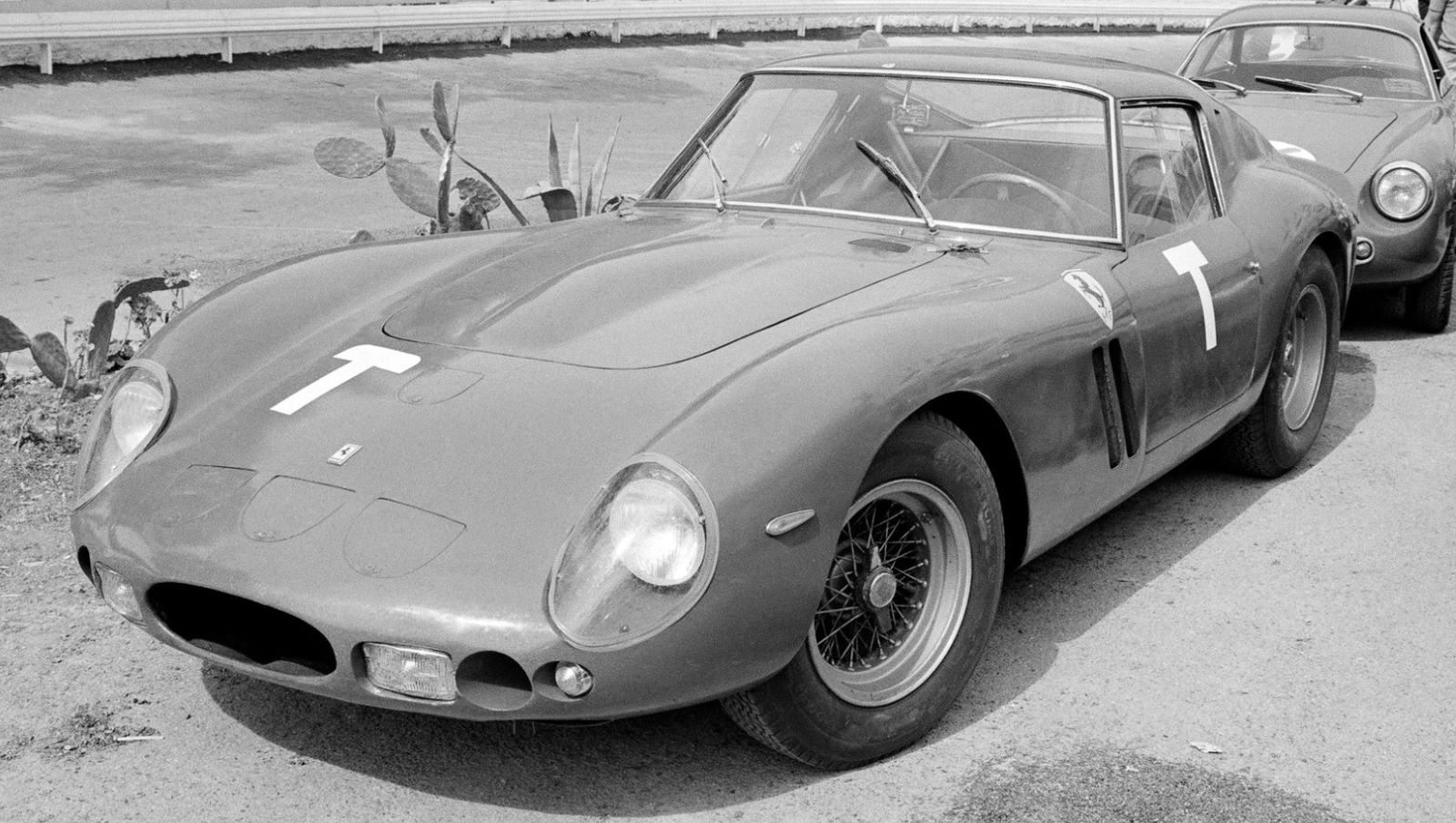
GRAN TURISMO OMOLOGATO
The Targa Florio class-winner, chassis 3413, is an absolutely outstanding example of the breed and among the very best of Ferrari’s 250 GTOs. Never again would the factory develop and build a so-called production GT car purely for the sake of racing. The 250 GTO’s rise was prompted by the creation of a new International Championship for GT Manufacturers in 1962, for which the 250 SWB Berlinetta was deemed to be insufficient. Longtime Ferrari engineer Giotto Bizzarrini knew that a fresh model would be required to remain competitive with the latest machines from Aston Martin, Jaguar, and Shelby American. The SWB’s front profile was too oblique to exceed 155 mph (the front end lifted at high speeds), and the rear dimensions could not accommodate the ever-widening tires.
For one of the first times in its history, Ferrari utilized a wind tunnel to test new coachwork, which eventually featured an extended, lowered nose, and a steeper windshield to reduce drag while maximizing downforce. The hood profile was lower than its predecessor’s, in part because the new tipo 539/62 COMP chassis allowed for the engine to be mounted closer to the ground. To retain full homologation eligibility, the new car retained general 250 GT chassis dimensions and the three-liter short-block Colombo V-12, which in tipo 168/62 competizione form featured six carburetors and larger valves (as in the Testa Rossa).
The revised tipo 539 chassis was improved with lighter tubing, stiffer springs, and dual Watts linkages that stabilized the rear suspension. A new five-speed gearbox was fitted to provide maximum acceleration and top speed. While the early 1962 examples featured bolted-on rear spoilers, starting in 1963 the spoiler was formally integrated into the coachwork. For 1964, of course, the Series II bodywork that was adopted was applied to the final three GTOs built, referred to as GTO/64, and retroactively upgraded to four Series I cars as referenced earlier.
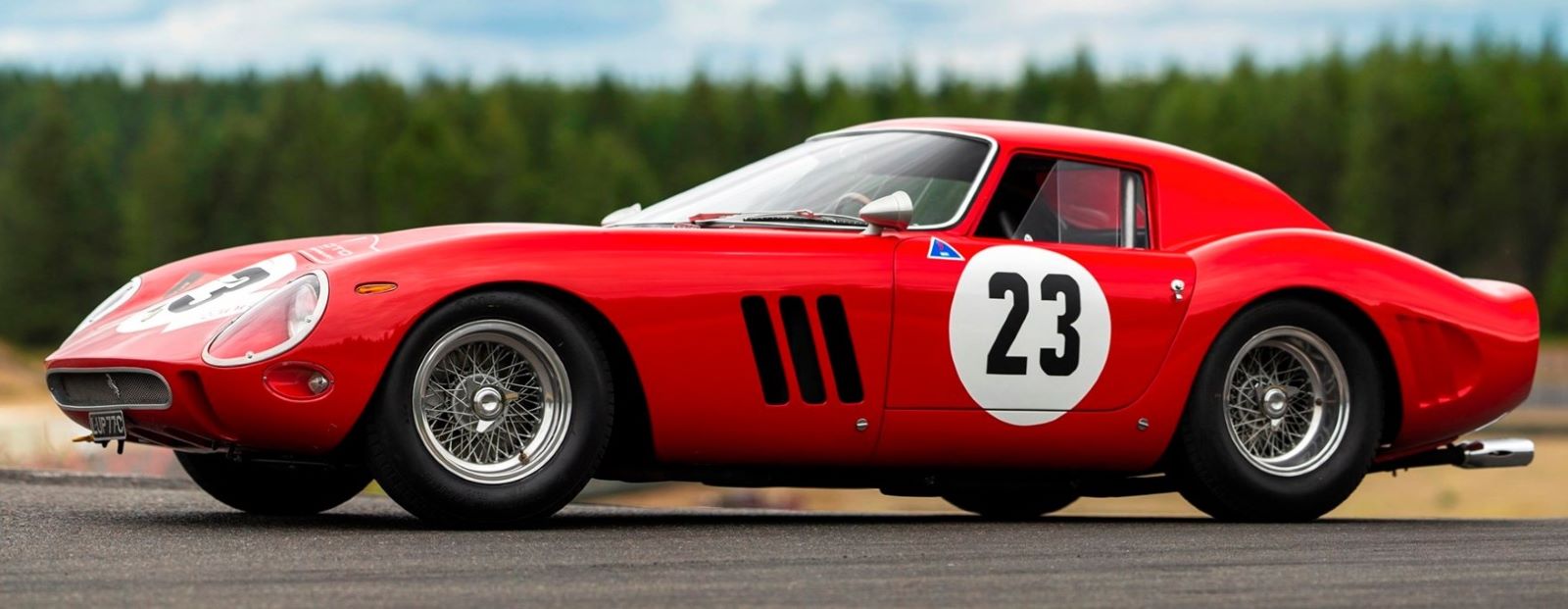
CHASSIS NUMBER 3413
This car is just the third production GTO built, completing factory assembly in late April 1962. It was the first GTO example to feature Series I coachwork details such as a small radiator intake, narrow brake ducts, hood fasteners, and sail-panel vents. Scaglietti’s coachwork also featured a bolted-on rear spoiler and turn signal lamps below the headlights. Fitted with a tipo 168/62 competizione V-12, the GTO was finished in rosso cina, and the interior was trimmed with traditional blue cloth upholstery.
In the first week of May, the Ferrari was driven by the legendary Phil Hill as SEFAC Ferrari’s official practice car for the upcoming Targa Florio. By this time, of course, Phil Hill’s importance to international American motor racing and indeed the Ferrari factory was well established. Not only had he already won Le Mans multiple times, he was also the first American Formula 1 World Champion and, quite indisputably, one of the world’s most talented and highly respected racing drivers. His presence behind the wheel of 3413 is a rare honor few cars in the world enjoy.
A few days later, the GTO was officially sold to Mrs. Arnalda Colombo, who purchased the car on behalf of her husband, the famed Italian privateer Edoardo Lualdi-Gabardi, one of the most charismatic and successful privateer drivers of the era and a personal friend of Enzo Ferrari who very consistently received the finest, special cars from the factory.
Born in Milan in 1931, Edoardo Lualdi-Gabardi began racing at the age of 19 with a Fiat Topolino in the 1950 Mille Miglia. In 1953 he began campaigning a Vignale-bodied Ferrari 166 MM spider, mostly in hill climbs. A year later his connection with Ferrari deepened when he began racing a freshly acquired 212 Export. He soon drove the first 250 MM berlinetta in competition, and a personal highlight was his triumph over champion racer Armando Zampieri’s Mercedes-Benz 300 SL.
In 1956 Lualdi-Gabardi acquired the first of four Ferrari 250 GT ‘Tour de France’ examples he would own, and it increasingly became his weapon of choice during an aggressive competition campaign from which he emerged as the 1956 Italian Hill Climb Champion. By the early 1960s the privateer was campaigning 250 GT SWB examples (including one of the rare SEFAC hot rods), and he later owned two GTO examples (including the featured car). Having purchased many Ferraris during this period, Lualdi-Gabardi soon found himself on Maranello’s preferred client list, and he apparently lunched with Enzo Ferrari frequently over the years. A crash in 1972 eventually forced the hill climb champion to permanently retire from racing, but not before he had triumphed (or earned class wins) in no fewer than 116 races, a remarkable feat by any measure.
Lualdi-Gabardi immediately began campaigning 3413 with great success in Italian hill climbs, starting with a victory at the Coppa Citta Asiago on 13 May. This was followed by a slew of class wins during the next month at hill climbs at Bologna-Raticosa, the Coppa Consuma, Bolzano-Mendola, and Trento-Bondone. The GTO then achieved several outright victories, starting with the Trieste–Opicina hill climb on 22 July, followed by the Trofeo Sarezzo-Lumezzane and the Coppa Faglioli in September, and the Coppa Autunno at Monza in October. Lualdi-Gabardi experienced such success in 3413 that at the season’s conclusion, he was declared the class champion for the 1962 Italian GT Championship.
In early April 1963 the GTO experienced a final overall victory with Lualdi-Gabardi at the Stallavena-Bosco Chiesanuova hill climb, and four days later the car was sold to its second owner, Gianni Bulgari, the scion and eventual president of the Bulgari watch company, who was no stranger to the race track and actively campaigned sports cars in period alongside the greatest gentlemen drivers. Bulgari first entered the Ferrari at the Targa Florio on 5 May, during the third round of the 1963 International Championship for GT Manufacturers, and achieved immediate success finishing 1st in class, 4th overall, with Maurizio Grana as his co-pilot. Six months later he won the Coppa FISA at Monza.
In merely its first calendar year, the feats of success that 3413 achieved are virtually unbelievable – feats of victory that speak not only to the talents of the drivers behind the wheel, but also to the world-class engineering at Ferrari that placed the GTO miles ahead, developmentally, of its competition on the track. One must consider the competition against which the Ferrari entered these races. Whether on the most legendary race tracks in Europe or local hill climbs in Italy, the GTOs were virtually on another level entirely, repeatedly and aggressively beating the competition. These were indeed the years in which the indelible image of a V-12 front-engined sports car, liveried in racing red with an iconic prancing horse became the international symbol of Ferrari’s racing dominance.
All these successes transpired before 3413 was driven to class victory at the Targa Florio the year after by Taramazzo and Ferlaino, at which point of course Ferlaino had commissioned the upgraded GTO/64 coachwork. Ferlaino raced the 250 at least three more times in 1964, earning a class win at the Bologna-Raticosa Hill Climb in late May and 3rd overall at the Mugello 500 KM a month later.
Shortly thereafter, 3413 was acquired by Dan Margulies, a dealer residing in London. At some point prior to December 1965, the front coachwork around the nose was slightly modified, with twin vertical vents for brake cooling added in place of the prior rectangular driving lights. In late December 1965, the car was entrusted to Maranello Concessionaires driver David Piper for the Redex Trophy at Brands Hatch where he claimed an outright victory, fittingly in 3413’s final period race. By the time the highly respected racing driver Piper got behind the wheel, he had already been very successful in single-seater racing, specifically Formula 2 and also Formula 1, and continues to remain active in the collector car hobby.
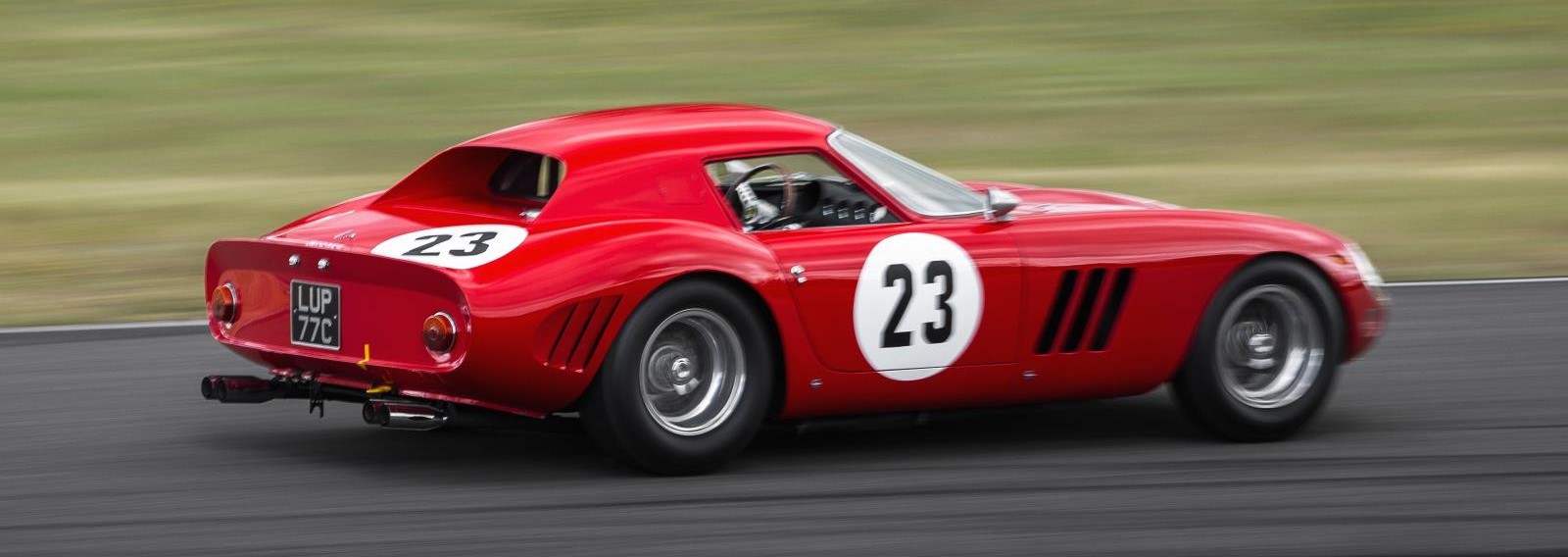
VINTAGE COMPETITION
In 1967 the GTO was sold by Margulies to Jack Le Fort, a fellow Englishman who ran the car twice at the Prescott Speed Hill Climb before selling it a year later to noted collector Neil Corner. In fact, the car’s entire vintage racing career and subsequent chain of ownership is not only incredibly illustrious, it includes the collection of gentlemen who are rightfully considered among the foremost motoring enthusiasts in the world and whose association with 3413 further serves to confirm the importance of such a car.
In 1970 Corner entered the GTO at a race held in conjunction with the Bugatti Drivers Club Meeting at Silverstone, and shortly afterwards the car was acquired by respected collector Lord Anthony Bamford of Stoke-on-Trent. Both Corner and Bamford have owned some of the rarest and most sought-after cars in the world, including multiple GTOs, no less, and their attention to acquiring the very best is impeccable. Lord Bamford attended the English Ferrari Owners Club meet at Prescott in July 1972 and retained possession of the spectacular GTO until the 1980s, when he sold the Ferrari to collector Nigel Moores.
In 1988 Moores sold 3413 to Japanese collector Yoshijuki Hayashi, though the car remained domiciled in the UK. The Ferrari participated in European vintage events during this ownership, including the GTO 30th Anniversary Tour in September 1992, and the Goodwood Festival of Speed in June 1993 (British restoration and racing expert Tony Merrick drove the car at both events). The GTO was purchased from Hayashi in April 1994 by Sir Lindsay Owen-Jones of London, then Chairman and CEO of L’Oréal and a respected motoring enthusiast in his own right – in fact, his association with the Ferrari brand is well established and includes serving on the board of directors of Ferrari SpA. Notable events in his ownership included a showing at the Coys Historic Race Festival at Silverstone in 1994 and 1995.
In January 2000, this highly significant Ferrari was purchased by the consignor, an esteemed collector based in the Pacific Northwest, who has continued to present, race, and rally the car at premium vintage events. In Dr. Gregory Whitten’s collection, the car kept company with the absolute best of the best and, over the years, this very collection has contained one of the finest Ferrari 250 LMs in existence, a superb SEFAC Hot Rod Le Mans class-winner, a 14-louvre Tour de France and an Alfa Romeo P3, to name but a very small sampling. In concert with an exceptional career in business, typified by an applied mathematics doctorate from Harvard, nearly two decades of work with Microsoft, and most recently the leadership of the financial software company Numerix, it is perhaps to be expected that Dr. Whitten’s passion for detail and expertise are embodied in his ownership of this GTO. Much to his credit, 3413 was regularly exhibited and driven around the world, including four appearances at the Cavallino Classic between 2001 and 2008 and four seasons in the Shell Ferrari Historic Challenge between 2001 and 2009. Chassis 3413 also participated in the GTO 40th Anniversary tour in September 2002; the Monterey Historic Races in August 2004, 2008, and 2011; the GTO 45th Anniversary tour in 2007; the Goodwood Revival Meeting in 2011; and the GTO 50th and 55th Anniversary tours, respectively, held in 2012 and 2017. The car was furthermore presented during the GTO celebration at the 2011 Pebble Beach Concours d’Elegance, where it was reunited with 17 of its GTO brethren. The car is most certainly one of the most actively campaigned and successful GTOs in the world.
A LEGEND WITHOUT EQUAL
Examples of the 250 GTO are very rarely offered for sale, let alone publicly, and 3413 is now available for the first time in over 18 years. As the third example produced, and the first to originally feature standard design details, 3413 is also notable as the primary steed in Edoardo Lualdi-Gabardi’s 1962 Italian GT Championship and a major contributor in 1964 to Ferrari’s final victory in the International Championship for GT Manufacturers. As one of only seven examples to be clothed in Scaglietti’s scintillating Series II coachwork (and one of two to feature the extended roofline), this 250 GTO is quite simply the most important Ferrari ever offered publicly.
In 2018, the car was inspected onsite and in person by representatives from Ferrari’s Classiche department, and interested parties are encouraged to speak with an RM specialist to review the report from this visit. Noted Ferrari historian and expert Marcel Massini also recently inspected the car and considers it one of the very best examples, pointing to its successes with Lualdi, its originality, and all its numbers-matching components (engine block, gearbox and rear axle), which are included with the car’s sale. Specifically, it should be noted that while the original gearbox and rear axle are currently fitted, the original engine block was astutely removed years ago for preservation, and is included with the car. The car is currently fitted with a 250 GT engine block built to GTO specification, thereby affording the new owner both the benefit of originality with the ability to drive the car as intended in vintage rallying or competition.
In the annals of automotive history, no initials loom larger than GTO. Claiming rarity, a long pedigree of mechanical development, beautifully sculpted coachwork, and an overwhelmingly successful competition record, the Ferrari 250 GTO has justifiably evolved into the world’s most desirable collector car: an instantly recognizable shape, a distinctive exhaust note, and a lustful presence that no other car in the world can claim. The rarity with which the model is publicly offered for sale confirms the desirability of the car and the ultra-exclusive members-only club that its ownership signifies: at any given point in time, 36 or fewer collectors can claim to be GTO owners. It is a club with virtually immediate access to the world’s most important automotive events, in which the mere arrival of a GTO is an historic occurrence and which there is never a barrier to entry. GTO owners count among their ranks captains of industry and luminaries of automotive collecting and, for many, acquisition of these cars is regarded the crowning achievement in an almost impossible hunt. The superb state and quality of 3413 further adds to this extreme rarity and makes its offering, quite literally, the opportunity of a lifetime – a moment in one’s collecting span that is quite likely unrepeatable. For one collector, then, there is no higher honor, there is no greater custodianship of history, and there is no greater achievement in the search of the world’s most important car.

| DATE | EVENT | RACE # | DRIVERS | RESULT |
|---|---|---|---|---|
| 1962 | ||||
| May 3-5, 1962 | Targa Florio | T | Phil Hill, Mauro Forghieri | Test Car |
| May 13, 1962 | Coppa Citta Asagio, Cengio-Tresche Hill Climb | 364 | Edoardo Lualdi-Gabardi | 1st OA |
| May 27, 1962 | Bologna-Raticosa Hill Climb | 232 | Edoardo Lualdi-Gabardi | 1st IC, 3rd OA |
| June 10, 1962 | Parma-Poggio di Bercerto Hill Climb | 358 | Edoardo Lualdi-Gabardi | 2nd IC, 8th OA |
| June 17, 1962 | Coppa Consuma Hill Climb | 374 | Edoardo Lualdi-Gabardi | 1st IC, 3rd OA |
| July 1, 1962 | Bolzano-Mendola Hill Climb | 248 | Edoardo Lualdi-Gabardi | 1st IC, 2nd OA |
| July 8, 1962 | Trento-Bondone Hill Climb | 372 | Edoardo Lualdi-Gabardi | 1st IC, 6th OA |
| July 22, 1962 | Trieste-Opicina Hill Climb | 362 | Edoardo Lualdi-Gabardi | 1st OA |
| August 26, 1962 | Ollon-Villars Hill Climb | 150 | Edoardo Lualdi-Gabardi | Practice |
| September 16, 1962 | Trofeo Sarezzo-Lumezzane | 177 | Edoardo Lualdi-Gabardi | 1st OA |
| September 23, 1962 | Coppa Fagioli, Ancona | 510 | Edoardo Lualdi-Gabardi | 1st OA |
| October 7, 1962 | Internationales Autorennen, Innsbruck Airfield | 112 | Edoardo Lualdi-Gabardi | Practice |
| October 14, 1962 | Coppa Autunno, Monza | 336 | Edoardo Lualdi-Gabardi | 1st OA |
| ITALIAN CHAMPIONSHIP | Edoardo Lualdi-Gabardi | 1st IC | ||
| 1963 | ||||
| April 7, 1963 | Stallavena-Boscochiesanuova Hillclimb | 794 | Edoardo Lualdi-Gabardi | 1st OA |
| May 5, 1963 | Targa Florio | 104 | Gianni Bulgari, Maurizio Grana | 1st IC, 4th OA |
| November 24, 1963 | Coppa FISA, Monza | 254 | Gianni Bulgari | 1st OA |
| 1964 | ||||
| April 26, 1964 | Targa Florio | 114 | Corrado Ferlaino, Luigi Taramazzo | 1st IC, 5th OA |
| May 24, 1964 | Coppa Consuma Hillclimb | Corrado Ferlaino | 4th IC | |
| May 31, 1964 | Bologna-Raticosa Hillclimb | 410 | Corrado Ferlaino | 1st IC, 8th OA |
| June 21, 1964 | Mugello 500 KM | 5 | Corrado Ferlaino | 3rd OA |
| 1965 | ||||
| December 26, 1965 | Redex Trophy, Brands Hatch | 78 | David Piper | 1st OA |

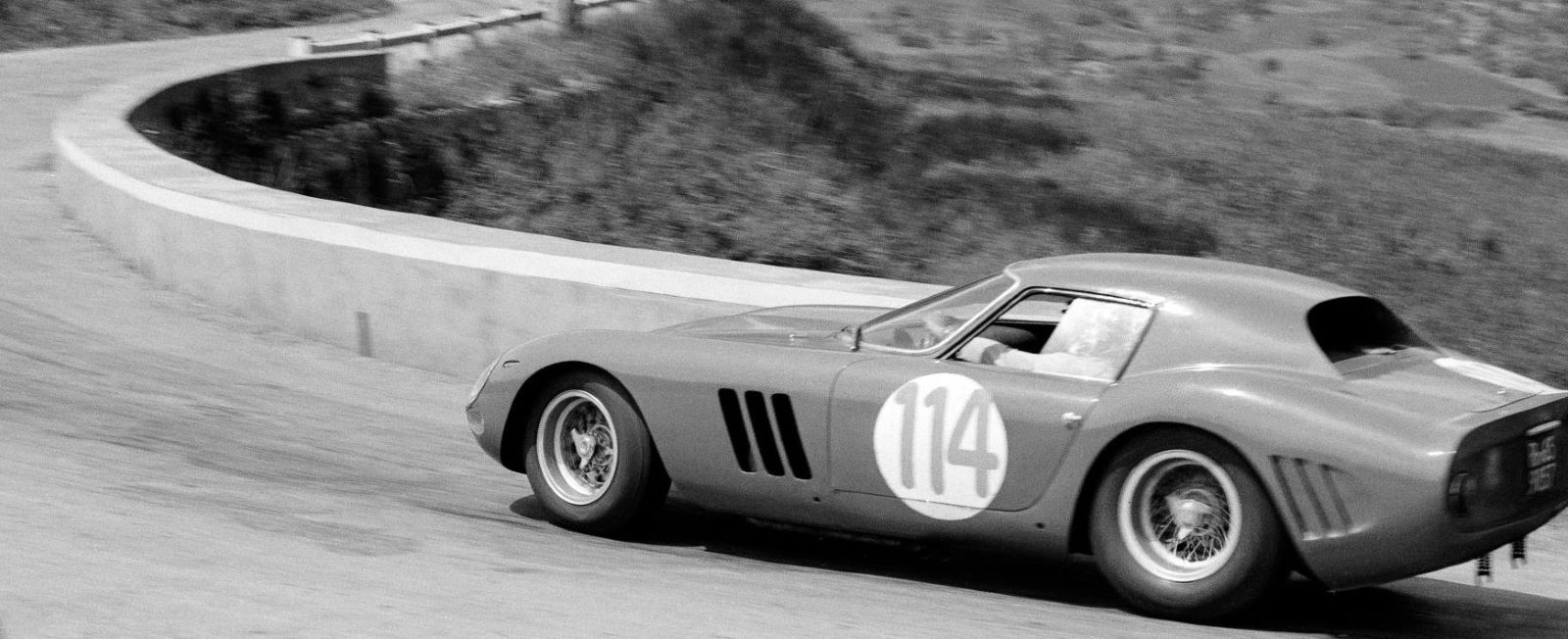

You must be logged in to post a comment.